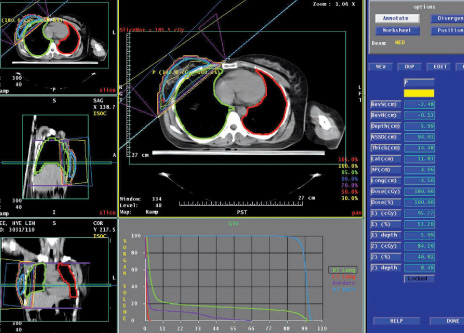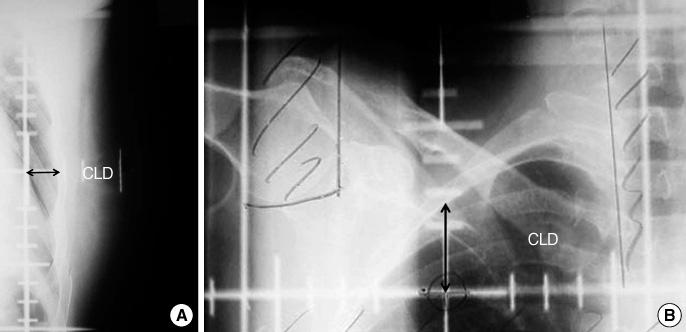J Breast Cancer.
2009 Jun;12(2):73-78. 10.4048/jbc.2009.12.2.73.
Radiation Pneumonitis after Adjuvant Radiotherapy for Breast Cancer: A Volumetric Analysis Using CT Simulator
- Affiliations
-
- 1Proton Therapy Center, Research Institute and Hospital, National Cancer Center, Goyang, Korea. radiat@ncc.re.kr
- 2Center for Breast Cancer, Research Institute and Hospital, National Cancer Center, Goyang, Korea.
- KMID: 2175198
- DOI: http://doi.org/10.4048/jbc.2009.12.2.73
Abstract
-
PURPOSE: To assess clinical factors and volumetric parameters associated with clinically significant symptomatic radiation pneumonitis (RP), which requires steroid medication after radiotherapy (RT).
METHODS
Medical records of 204 irradiated breast cancer patients were reviewed. Percent lung volume (PLV) receiving more than 20 Gy was measured from CT-based treatment plan and was correlated with the central lung distance (CLD) of local and regional fields. PLV was also evaluated as a predictive factor of symptomatic RP, along with other previously reported clinical factors.
RESULTS
Average (+/-standard deviation) actual irradiated lung volume and PLV for breast/chest wall irradiation were 169 (+/-50.6) cm3 and 14.9 (+/-3.8)%, respectively. Addition of regional irradiation resulted in increase of 183 (+/-80.2) cm3 in actual irradiated lung volume and 16.5 (+/-6.2)% in PLV. The correlation between CLD of the local fields and PLV was significant, with 1 cm of CLD corresponding to approximately 6% of PLV. CLD of the regional field was also significantly associated with PLV: a CLD of 3 cm corresponds to a PLV of approximately 13%; a CLD of 4 cm, approximately 17%; and a CLD of 5 cm, approximately 21%. RP developed in 11 patients (5.4%). There was an increased incidence of RP among patients who underwent local RT vs local and regional RT (2.4% vs 12.1%, p=0.0192). In terms of PLV, total PLV > or =23% was associated with the development of RP (p=0.0467). Previously reported clinical factors failed to show statistically significant association.
CONCLUSION
Correlation between CLD and PLV for local and regional fields was significant on volumetric analysis. Although symptomatic RP requiring steroid medication was a rare complication, regional irradiation increased the incidence of RP, and such relationship can be expressed with a volumetric parameter of PLV.
MeSH Terms
Figure
Cited by 2 articles
-
Dose-Volume Analysis of Lung and Heart according to Respiration in Breast Cancer Patients Treated with Breast Conserving Surgery
Jae-Goo Shim, Jeong-Koo Kim, Won Park, Jeong-Min Seo, Chae-Sun Hong, Ki-Won Song, Cheong-Hwan Lim, Hong-Ryang Jung, Chan-Hyeong Kim
J Breast Cancer. 2012;15(1):105-110. doi: 10.4048/jbc.2012.15.1.105.Correlation of Conventional and Conformal Plan Parameters for Predicting Radiation Pneumonitis in Patients Treated with Breast Cancer
Cem Onal, Ezgi Oymak, Ayse Kotek, Esma Efe, Gungor Arslan
J Breast Cancer. 2012;15(3):320-328. doi: 10.4048/jbc.2012.15.3.320.
Reference
-
1. Lingos TI, Recht A, Vicini F, Abner A, Silver B, Harris JR. Radiation pneumonitis in breast cancer patients treated with conservative surgery and radiation therapy. Int J Radiat Oncol Biol Phys. 1991. 21:355–360.
Article2. Gagliardi G, Bjöhle J, Lax I, Ottolenghi A, Eriksson F, Liedberg A, et al. Radiation pneumonitis after breast cancer irradiation: analysis of the complication probability using the relative seriality model. Int J Radiat Oncol Biol Phys. 2000. 46:373–381.
Article3. Lind PA, Marks LB, Hardenbergh PH, Clough R, Fan M, Hollis D, et al. Technical factors associated with radiation pneumonitis after local±regional radiation therapy for breast cancer. Int J Radiat Oncol Biol Phys. 2002. 52:137–143.
Article4. Allen AM, Prosnitz RG, Ten Haken RK, Normolle DP, Yu X, Zhou SM, et al. Body mass index predicts the incidence of radiation pneumonitis in breast cancer patients. Cancer J. 2005. 11:390–398.
Article5. Bornstein BA, Cheng CW, Rhodes LM, Rashid H, Stomper PC, Siddon RL, et al. Can simulation measurements be used to predict the irradiated lung volume in the tangential fields in patients treated for breast cancer? Int J Radiat Oncol Biol Phys. 1990. 18:181–187.
Article6. Das IJ, Cheng EC, Freedman G, Fowble B. Lung and heart dose volume analyses with CT simulator in radiation treatment of breast cancer. Int J Radiat Oncol Biol Phys. 1998. 42:11–19.
Article7. Neal AJ, Yarnold JR. Estimating the volume of lung irradiated during tangential breast irradiation using the central lung distance. Br J Radiol. 1995. 68:1004–1008.
Article8. Minor GI, Yashar CM, Spanos WJ Jr, Jose BO, Silverman CL, Carrascosa LA, et al. The relationship of radiation pneumonitis to treated lung volume in breast conservation therapy. Breast J. 2006. 12:48–52.
Article9. Kim TH, Cho KH, Pyo HR, Lee JS, Zo JI, Lee DH, et al. Dose-volumetric parameters for predicting severe radiation pneumonitis after three-dimensional conformal radiation therapy for lung cancer. Radiology. 2005. 235:208–215.
Article10. Graham MV, Purdy JA, Emami B, Harms W, Bosch W, Lockett MA, et al. Clinical dose-volume histogram analysis for pneumonitis after 3D treatment for non-small cell lung cancer (NSCLC). Int J Radiat Oncol Biol Phys. 1999. 45:323–329.
Article11. Tsujino K, Hirota S, Endo M, Obayashi K, Kotani Y, Satouchi M, et al. Predictive value of dose-volume histogram parameters for predicting radiation pneumonitis after concurrent chemoradiation for lung cancer. Int J Radiat Oncol Biol Phys. 2003. 55:110–115.
Article12. Blom-Goldman U, Svane G, Wennberg B, Lideståhl A, Lind PA. Quantitative assessment of lung density changes after 3-D radiotherapy for breast cancer. Acta Oncol. 2007. 46:187–193.
Article13. Kwa SL, Lebesque JV, Theuws JC, Marks LB, Munley MT, Bentel G, et al. Radiation pneumonitis as a function of mean lung dose: an analysis of pooled data of 540 patients. Int J Radiat Oncol Biol Phys. 1998. 42:1–9.
Article14. Taghian AG, Assaad SI, Niemierko A, Kuter I, Younger J, Schoenthaler R, et al. Risk of pneumonitis in breast cancer patients treated with radiation therapy and combination chemotherapy with paclitaxel. J Natl Cancer Inst. 2001. 93:1806–1811.
Article15. Yu TK, Whitman GJ, Thames HD, Buzdar AU, Strom EA, Perkins GH, et al. Clinically relevant pneumonitis after sequential paclitaxel-based chemotherapy and radiotherapy in breast cancer patients. J Natl Cancer Inst. 2004. 96:1676–1681.
Article16. Markiewicz DA, Schultz DJ, Haas JA, Harris EE, Fox KR, Glick JH, et al. The effects of sequence and type of chemotherapy and radiation therapy on cosmesis and complications after breast conservation therapy. Int J Radiat Oncol Biol Phys. 1996. 35:661–668.
Article
- Full Text Links
- Actions
-
Cited
- CITED
-
- Close
- Share
- Similar articles
-
- Internal Mammary Lymph Node Irradiation after Breast Conservation Surgery: Radiation Pneumonitis versus Dose?Volume Histogram Parameters
- The Studies on the Development of Radiation Pneumonitis and Its Related Factors
- Probabilities of Pulmonary and Cardiac Complications and Radiographic Parameters in Breast Cancer Radiotherapy
- Radiation Induced Lung Damage : Mechanisms and Clinical Implications
- Radiotherapy for Breast Cancer




